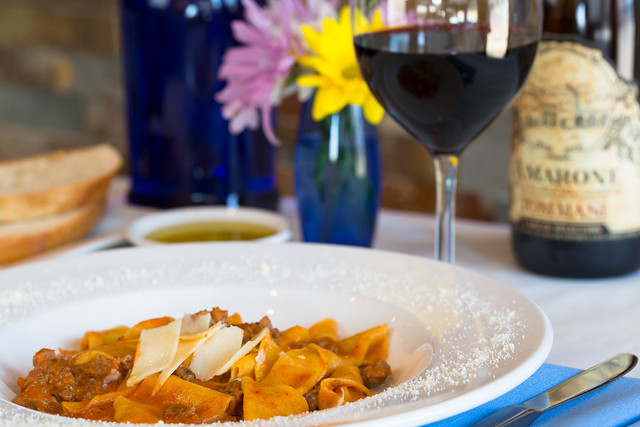Yes! This is much better... white balance is looking better (things that should be "white" are white)!
Focus needed to come forward just a touch (the focus favors the back of the bowl rather than the center of it). This is tough to do while looking through the viewfinder. I do my food shots with the camera "tethered" to the computer so I can review the shots as I take them (and I always use manual focus only).
The tomatoes and garlic bulbs help the shot. A very tiny saturation boost may improve it even more (use sparingly... I tell people it's like seasoning the food... a little is good, but too much ruins it.)
If you have software such as Adobe Lightroom, consider trying to the "vibrance" adjustment instead of the "saturation" adjustment. Vibrance and Saturation do pretty much the same thing EXCEPT "vibrance" tries to protect the colors associated with skin tones. This means it would probably give the green more of a saturation boost then the reds. Sometimes it works better (especially when actual "skin" is visible in a shot -- such as portraits) ... but sometimes saturation (instead of vibrance) gives you a better result.
The idea of fussing over the table and food (use of props, etc.) is all part of "food styling" and sometimes there's a professional food stylist who does this (sort in the same way a person might hire an interior decorator to decorate the home... a food stylist primps up the look of the food -- both the food itself and the table setting).
I find that when you get in close to show details of the food, the area of the table that shows up in the shot gets smaller and sometimes you need to move the props a bit closer and cozy everything up. Experiment with bringing things in tighter and evaluate the look. Often even though things really are pulled in tight (a person in the room realize you've got this big table and everything is tightly arranged in a small area instead of nicely space out in a proper "place setting") the camera can't see the whole table... so it won't look like it's tight and cozy.
Here's an example:

Tagliatelle di Bosco by
Tim Campbell, on Flickr
Everything in this shot is actually pretty close together... the wine glass is practically touching the plate. The flowers, bread, oil, etc. are all pretty close. Even that wine bottle is pretty close.
But since you can't see the "whole" table, it doesn't occur to the viewer just how close everything is.
Fussing over the shot:
Also keep in mind that everything you see in your food photos (or any photo really)
counts!
As I look at the shot, I see that the bowl is placed on what appears to be a white plastic cutting mat, and it looks a bit dirty. That part isn't working... if you want to use a cutting surface, use a rustic looking cutting board. Otherwise put it on a clean and neat surface.
For example, the cloth napkin you see in this shot is pristinely clean (inspect those details) and the knife was also inspected to make sure it's free of scratches, smudges, etc. The wine glass, vase, glass bottles, etc. are all checked to make sure they are free of smudges, etc. In your shot I'm noticing the fork looks like it has some scratches on it (inspect your forks to choose the one that will work best with the shot.)
If, when the food is plated, there any food splatter around the rim, then that's wiped off with a moist cloth to present a perfect bowl.
Even the reflections you see in the wine glass are planned. I carry a huge black tablecloth and "A clamps" from the hardware store so that I can block windows that put reflections in undesirable places.
A food stylist will even use giant food tweezers or food forceps so they can primp the food. We didn't do in this shot, but see those parmesan cheese shavings? THIS dish of pasta is not THE dish of pasta that the chef made for the shot. The original dish had the cheese shavings placed on it almost immediately as it was plated and the cheese melted into the food. I had him pull that off, re-top the dish, let it cool slightly, and THEN place the shaved bits of cheese on the food so it would hold its form better. Some food stylists would fuss over "which" cheese shaving has the nicest looking "curl" to it and would hand pick the shaves, and use giant tweezers to place the shavings in just the right spot.
This is what I mean by "everything counts" -- everything you can see in the shot -- even if not the feature of the shot -- still counts toward the overall look and appeal of the shot (and appeal of the food). In a different food shoot I didn't like the walls in the background, so I grabbled a tri-fold floor-standing screen and placed that in the background (but not too close to the place setting so as to make sure it was well out of focus) and used that instead because I preferred the look and color.
Translating this back to your shot...
Fuss over the leaf-garnish (looks like basil) and try to find perfect specimens of leaves. Fuss over the fork selection. Lose the place mat and replace with a clean one (or nothing if the table surface looks good and just tuck in a clean cloth napkin or clean kitchen towel.)
This newest shot of yours is looking much more inviting and appetizing! Nice work.











![[No title]](/data/xfmg/thumbnail/37/37537-25afab1a7980214af6067df3c997c353.jpg?1734170693)

![[No title]](/data/xfmg/thumbnail/37/37126-93feffeca0e9e6ad893962c03a7a341e.jpg?1734169833)
